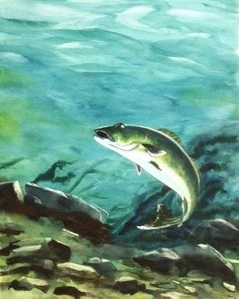Latest on Walleye Fishing Around the State - Outdoor News
Walleye Fishing
The best walleye populations are found in Midwest lakes that are sandy, windswept, and moderately fertile. Generally, these lakes have a walleye’s favorite food, yellow perch, in healthy numbers.
These types of lakes are also likely to carry a wide variety of other gamefish. Most have largemouth bass, sunfish, crappies, northern pike and maybe smallmouth bass and muskies.
The location of walleyes depends on the oxygen content of the lake. Many fertile lakes lack oxygen in the depths in summer, forcing walleyes into the shallows often 10 feet or less in depth.
Spawning
The ideal spawning habitat for walleyes is created when constant waves expose rubble along the shoreline. This perpetual motion of water keeps eggs aerated and prevents them from silting over.
Walleyes are best suited for larger and/or rounder lakes where spawning is ideal (wind-swept shorelines). Spawning begins when the water warms to about 48°. During this time and up to 10 days afterwards, females rarely bite. The smaller males will bite during this time. Luckily for fishermen, walleyes go on a month-long feeding binge after spawning. The best places to fish at this time in usually in water 15 feet or less. The low angle of the sun’s ray allows them to stay in the shallows all day, because it has little effect on their light-sensitive eyes.
[Walleye print at right is available at: www.paintingsprintsandarts.com]
Where to find Walleyes
Walleyes are found most of the time in 30 feet of water or less. In deep lakes, walleyes are found along shorelines and shallow midlake bars. Shallow lakes, for these reasons, support many more walleyes than deeper ones.
Most walleyes are caught at night or in cloudy, breezy weather. Breezy, choppy waters help deflect the rays of the sun, allowing walleyes (who are light sensitive) to venture out of their regular hangouts. On calm, sunny days, walleyes spend most of their time in the shade or near weeds. The low angle of the sun in the spring makes cover less important. After the fishing opener in mid-May, walleyes are moving through shallow water in search of food. Look for them at this time on points, inside turns along sand shoreline breaks, and rocky midlake humps. Lakes and rivers with murky waters that screen out the sunlight should be fished during the daytime.
Night fishing with a slip-bobber and leech is an excellent way for catching walleyes in spring. Anchor on the edge of a break just before sunset and cast into four to eight feet of water. Trolling with a shallow-running minnow plug also works. There is usually a good bite for three to fours hours after dark.
Mid-Summer Fishing offers a less favorable Bite
Most walleyes hand around at depths of 12 to 18 feet along the edge of the break during the day. Slow trolling with a slip-sinker rig with a leech or casting with a jig and minnow are good methods of catching them. During summer nights, troll in eight to ten feet of water along the tops of the midlake flats, next to the drop-off.
Mid-summer is the least productive walleye-fishing season because yellow perch and other baitfish reach an attractive size. When two to three inch perch are readily available walleyes become harder to catch.
Fall offers a good Bite for Walleyes
Walleyes tend to go deeper around the middle of September, moving back into weeds at night, especially green ones. During the day, they tend to stay at depths of 25 to 35 feet, along the edge of a break. Steeper slops generally hold more walleyes than more gradual ones. The fish are feeding more aggressively when they enter deeper waters, and midday fishing improves as well. Larger baits, like a three to four inch minnow on a jib or slip-sinker rig, work well.
Ice Fishing for Walleyes
Early in the ice-fishing season, walleyes can be found in 10 to 12 feet of water on points along the midlake flats. Around the middle of January, they are more likely to be found in 18 to 30 feet, on the ends of cabbage humps or the same points along the midlake flats.
Walleyes generally move to shallower waters when snow cover is heavy, the sky is overcast, or it’s early or late in the day. They usually go deeper when it’s midday, in sunny weather, or under light snow cover.
Ice-Fishing Equipment
· Light tackle
· For tip-ups, use a six-pound mono leader, a split-shot or two and a size 4 hook
· For jigging, use a three-foot, medium-power jigging rod, a small spinning reel and six-pound mono